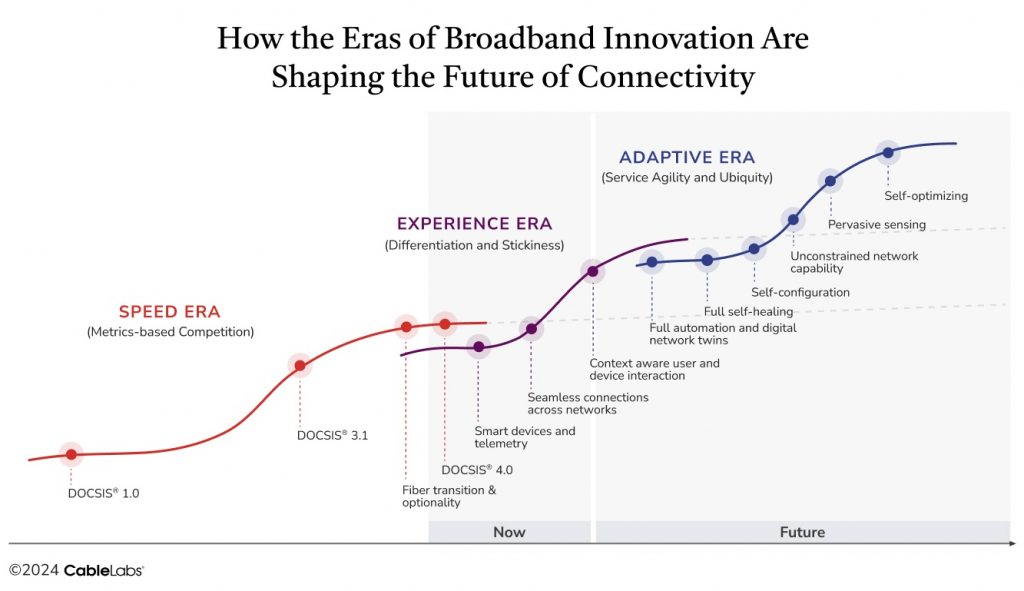Technology Vision
Beyond Speed: The New Eras of Broadband Innovation

Key Points
- CableLabs’ Technology Vision outlines three eras of broadband innovation: speed, experience and adaptivity.
- Tailored, seamless and adaptive experiences of the future will require industry collaboration and ecosystem interoperability.
Still trying to attract customers based on ever-increasing gigabit speeds? That may not be enough to gain a competitive advantage in today’s broadband industry. We’re entering a new era — one in which the market prioritizes seamless connectivity over technical metrics.
Users want technology that will work everywhere all the time, with no disruptions. It doesn’t matter to them if an operator can deliver 100 gigabits per second if their connection drops at a pivotal moment.
The broadband industry has reached a tipping point at which additional gains in speed no longer offer substantial improvements to customer experiences that they used to. As quality of service (QoS) has improved over time, user expectations have also evolved. Users spend more and more time online, and they want higher-quality experiences and predictable delivery that won’t glitch or drop as they go about their day, whether they’re at home, on the go or anywhere in between.
In other words, users don’t want to think about their networks. They just want them to work, wherever they happen to be.
To achieve this outcome, the industry needs a network that can anticipate and adapt to users’ needs in real time as they move between networks and applications. Ultimately, the goal is ubiquitous, context-aware connectivity that fades into the background.
How do we get there? First, let’s take a look at the three eras of broadband innovation outlined in CableLabs’ Technology Vision: speed, experience and adaptivity.
Where We Started: The Speed Era
The early days of broadband innovation focused on metrics. Speed was the moving target for DOCSIS®️ 1.0 and DOCSIS 3.1 technologies, and the aim was to improve metrics that were visible to consumers. Companies touted faster and faster speeds as a competitive differentiator, and today we can deliver 10 gigabits per second, with even greater speed increases on the horizon.
While it is foundational to the future of the industry, speed has reached a saturation point. It has ceded its place as the primary driver of usage and is now an expectation, not a differentiator. Faster speeds are certainly likely in the future, but the focus has shifted to delivering explicit value in terms of experience.
Where We Are: The Experience Era
Broadband usage has reached an inflection point, with users requiring such services in nearly every aspect of their lives. They expect their networks to be not only reliable — and reliably fast — but also to transform the way they live, work, learn and play by enabling optimal experiences throughout all of their online interactions. Seamless connectivity has become the new target for the online experience.
Realizing these customer expectations will require advances in smart devices and telemetry, seamless connections across networks, and context-aware user and device interactions. Operators will also need to have a comprehensive understanding of network performance and how it impacts application experiences.
DOCSIS 4.0 technology moves us closer to seamless user experiences with its capability for delivering symmetrical multi-gigabit speeds while supporting high reliability, high security and low latency. Although network technology innovations have expanded user experience measures beyond speed, true seamless connectivity remains elusive.
There’s no one-size-fits-all solution to the seamless connectivity problem. In addition to the performance of their individual networks, providers must also consider:
- How to optimize the hand-off as customers move from one network to another
- How various user applications and devices impact the user experience
- How to meet the increasing demand for tailored experiences that anticipate needs before a disruption occurs
- How to deliver uninterrupted experiences as users move through various environments
Online experiences in an environment such as a hotel, for example, are currently dependent on that hotel’s Wi-Fi. This means the connection could be glitchy or service may be disrupted, leaving customers frustrated and their expectations unmet. The goal in the experience era is to ensure a Wi-Fi experience that matches those expectations no matter where the user is.
The problem is that measuring a user’s actual experience isn’t easy. We have limited intelligent network metrics today that help us predict what the experience will be, and there’s still significant work to be done in this area.
Still, we’ve seen some promising developments in correlating metrics with experiential outcomes.
In recent work conducted by CableLabs, we’ve explored the potential of correlating application Key Performance Indicators (KPIs) to network KPIs. Through our work on Quality by Design (QbD), we can leverage the customer’s lived application experience to identify network impairments and take action on those issues before the user’s experience degrades. This could alleviate frustrating customer experiences and eliminate many unnecessary customer service interactions that result from not understanding the user’s experience in real time.
Where We’re Headed: The Adaptive Era
Ultimately, the emphasis on user experience will segue into an adaptive era that leverages self-configuration, sensing components for understanding environmental factors and predictive algorithms that anticipate future events to ensure uninterrupted experiences. Networks of the future will be smarter, more capable and less visible, essentially fading into the background.
To achieve this result, industry stakeholders will need to work together toward continued increases in capacity, significant enhancements in reliability and network intelligence, and increased network understanding to facilitate proactive responses. Focus areas in the adaptive era will include:
- Full Automation and Digital Network Twins — As more smart components are built into technology, we’ll gain access to telemetry that isn’t on the network today. The data will help us understand network performance in greater detail and build automation into the network.
- Full Self-Healing — The network will identify failures or weak points and automatically re-route data or allocate resources to maintain functionality.
- Self-Configuration — We have some self-configuration technology today, but it’s still fairly primitive. In the adaptive era, learning algorithms will be built in, fully responsive and able to configure themselves to the environment and the way users interact.
- Unconstrained Network Capabilities — Customers will be able to access their services from anywhere with Network as a Service (NaaS). Achieving this goal will require partnerships across providers and networks to create common understanding.
- Pervasive Sensing — The ability to sense fiber components, Wi-Fi, construction and other events will empower predictive adaptability and proactive responses.
- Self-Optimizing — By constantly analyzing performance metrics and user requirements, networks of the future will be able to optimize resource allocation, routing paths and other parameters for best performance.
The infrastructure to create these kinds of experiences is still in the early stages of development. However, we’re starting to see broadband innovations that incorporate adaptive elements. Examples include:
- Automated Profile Management Changes — Built-in mechanisms detect a problem in a section of the network and shift the traffic to a different range inside that frequency.
- Smart Home Technology — Networks are evolving to connect smart devices securely without user intervention, enabling simpler, more dynamic user experiences.
- Environmental Sensing — Using various sensors and algorithms, networks can sense environmental events (e.g., seismic activity, nearby construction, etc.) and alert first responders or respond to avoid an outage.
What’s Next for the Industry?
Delivering true seamless connectivity — and enabling truly optimal application experiences — won’t happen overnight. To get there, we’ll need to work together as an industry to solve complex system-level issues and develop common platforms for interoperability.
As a whole, the industry must transition from its focus on improving network metrics such as speed. Operators must prioritize delivering tailored, seamless and adaptive experiences built on interoperability. Doing so will require common interfaces to support interoperability, integrated definitions and data structures, as well as collaboration across providers and networks.
The CableLabs Technology Vision seeks to move the industry forward by helping our members provide superior customer experiences everywhere and aligning the industry on a concise model for building adaptive networks through:
- Seamless Connectivity
- Network Platform Evolution
- Pervasive Intelligence, Security and Privacy
To design and implement the technologies and operational models of the future, operators will need to develop a common understanding that transforms the vision of the adaptive era into a reality for every customer. Together, we can deliver network solutions that are flexible, reliable and capable of enabling new services and improved user experiences.



